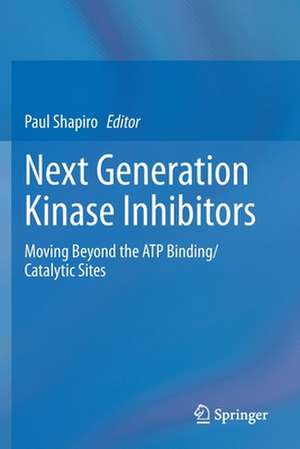Next Generation Kinase Inhibitors: Moving Beyond the ATP Binding/Catalytic Sites
Editat de Paul Shapiroen Limba Engleză Paperback – 14 iul 2021
| Toate formatele și edițiile | Preț | Express |
|---|---|---|
| Paperback (1) | 901.50 lei 6-8 săpt. | |
| Springer International Publishing – 14 iul 2021 | 901.50 lei 6-8 săpt. | |
| Hardback (1) | 908.44 lei 6-8 săpt. | |
| Springer International Publishing – 14 iul 2020 | 908.44 lei 6-8 săpt. |
Preț: 901.50 lei
Preț vechi: 948.95 lei
-5% Nou
Puncte Express: 1352
Preț estimativ în valută:
172.53€ • 179.45$ • 142.43£
172.53€ • 179.45$ • 142.43£
Carte tipărită la comandă
Livrare economică 14-28 aprilie
Preluare comenzi: 021 569.72.76
Specificații
ISBN-13: 9783030482855
ISBN-10: 3030482855
Ilustrații: XII, 217 p. 59 illus., 56 illus. in color.
Dimensiuni: 155 x 235 mm
Greutate: 0.33 kg
Ediția:1st ed. 2020
Editura: Springer International Publishing
Colecția Springer
Locul publicării:Cham, Switzerland
ISBN-10: 3030482855
Ilustrații: XII, 217 p. 59 illus., 56 illus. in color.
Dimensiuni: 155 x 235 mm
Greutate: 0.33 kg
Ediția:1st ed. 2020
Editura: Springer International Publishing
Colecția Springer
Locul publicării:Cham, Switzerland
Cuprins
Chapter 1: Introduction to Kinases, Cellular Signaling, and Kinase Inhibitors. [Paul Shapiro et al.]
Chapter 2: Overview of Current Type I/II Kinase Inhibitors. [Zheng Zhao, Philip E. Bourne]
Chapter 3: Avoiding or Co-opting ATP Inhibition: Type III, IV, V, and VI Kinase Inhibitors. [Paul Shapiro et al]
Chapter 4: Structural Features Regulating Kinase Interactions with Regulatory and Substrate Proteins. [Paul Shapiro et al.]
Chapter 5: Developing Kinase Inhibitors using Computer-Aided Drug Design Approaches [Yu et al.]
Chapter 6: A Toolbox of Structural Biology and Enzyme Kinetics Reveals the Case for ERK Docking Site Inhibition [Rachel Sammons and Kevin Dalby]
Chapter 7: Novel Stabilized Peptide Inhibitors of Protein Kinases (Helton et al.)
Chapter 8: Novel peptide-based inhibitors of protein kinases [Justin Holub]
Chapter 2: Overview of Current Type I/II Kinase Inhibitors. [Zheng Zhao, Philip E. Bourne]
Chapter 3: Avoiding or Co-opting ATP Inhibition: Type III, IV, V, and VI Kinase Inhibitors. [Paul Shapiro et al]
Chapter 4: Structural Features Regulating Kinase Interactions with Regulatory and Substrate Proteins. [Paul Shapiro et al.]
Chapter 5: Developing Kinase Inhibitors using Computer-Aided Drug Design Approaches [Yu et al.]
Chapter 6: A Toolbox of Structural Biology and Enzyme Kinetics Reveals the Case for ERK Docking Site Inhibition [Rachel Sammons and Kevin Dalby]
Chapter 7: Novel Stabilized Peptide Inhibitors of Protein Kinases (Helton et al.)
Chapter 8: Novel peptide-based inhibitors of protein kinases [Justin Holub]
Notă biografică
Paul Shapiro has a long-standing interest in protein kinases and their role in regulating cellular functions during disease. Specific areas focus on the discovery and development of function-selective mitogen-activated protein (MAP) kinase inhibitors with the goal of mitigating cancer cell proliferation and inflammation-induced lung injury associated with respiratory diseases. He received a Bachelor of Science degree from the University of Wisconsin-Madison and his doctorate in molecular physiology and biophysics from the University of Vermont. Dr. Shapiro completed post-doctoral training in the Department of Chemistry and Biochemistry at the University of Colorado-Boulder and is currently a professor of Pharmaceutical Sciences at the University of Maryland School of Pharmacy.
Textul de pe ultima copertă
Protein kinases are fascinating enzymes that maintain the proper function of nearly every task performed by the cells of the human body. By extracting a phosphate from the energy molecule ATP and linking it to another protein, protein kinases alter the structure and ultimate function of other proteins. In this way, protein kinases help monitor the extracellular environment and integrate signaling cues that, for the most part, are beneficial for human health and survival. However, protein kinases are often dysregulated and responsible for the initiation and progression of many types of cancers, inflammatory disorders, and other diseases. Thus, decades of research have revealed much about how protein kinases are regulated and approaches to inhibit these enzymes to treat disease. However, nearly 30 years since the identification of the first clinically beneficial small molecule protein kinase inhibitor, there are only a few examples where these drugs provide sustained and durable patient responses. The goal of this book is to provide biomedical scientists, graduate, and professional degree students insight into different approaches using small molecules to block specific protein kinase functions that promote disease.
Caracteristici
This book provides a brief review of drug development efforts and FDA approved kinase inhibitors
This book sets the stage and highlights the importance of kinase signaling pathways in physiological processes
This book identifies the genetic mutations that lead to kinase dysregulation and how this promotes the growth and survival of cancer cells
The book discusses the emergence of resistance to kinase inhibitors
This book sets the stage and highlights the importance of kinase signaling pathways in physiological processes
This book identifies the genetic mutations that lead to kinase dysregulation and how this promotes the growth and survival of cancer cells
The book discusses the emergence of resistance to kinase inhibitors
